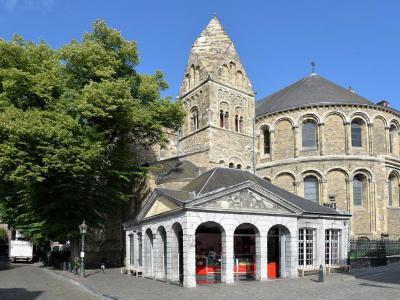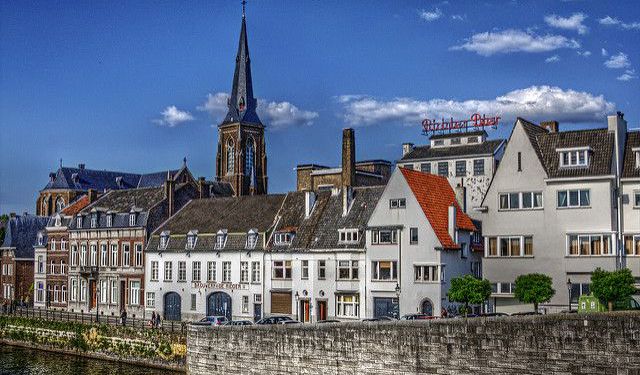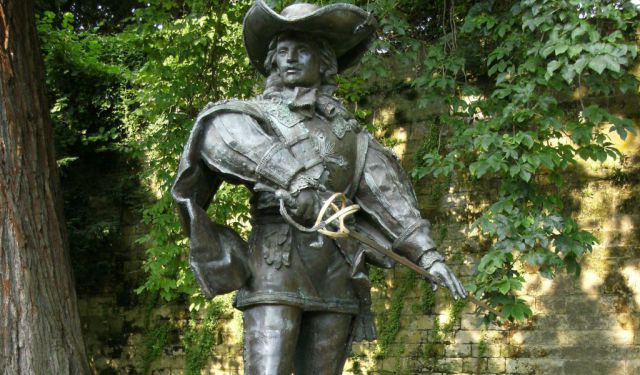
Onze-Lieve-Vrouwekerk (Basilica of Our Lady), Maastricht (must see)
The Basilica of Our Lady is a Romanesque Roman Catholic Church, often called Star of the Sea, after the church's main devotion, Our Lady, Star of the Sea.
It's possible that a Roman temple was built on this site before the church was built. Most of the present structure was built in the 11th and 12th centuries. The westwork was built in the 11th century, and Gothic vaults were added in the 13th century.
The French Occupation used the church as a stable and a blacksmith shop during the 1790s. The church was finally returned to a place of worship in 1837.
Visitors can access the church from the Square of Our Lady through a 13th-century Gothic portal.
The interior features a 14th-century mural depicturing Saint Catherine. A mural from 1571 depicts Saint Christopher and the Infant Jesus. The church features a 1652 pipe organ, while the stained glass windows date to the 19th and 20th centuries.
Twenty symbolic capitals carved in the 12th century depict Old Testament scenes. Impressive artworks include a 14th-century Pieta sculpture, a 16th-century wood panel The Dream of Jacob, and two 15th century Virgin Mary statues.
The church features a cloistered garden that dates to the 16th century.
A 15th-century wooden statue of Our Lady, Star of the Sea is located in a chapel by the main entrance. Pope Pius X crowned the statue in 1912. The statue is carried around town during religious processions.
The Basilica of Our Lady houses an impressive treasury. The treasury includes busts of silver and copper, chalices, ancient vestments, antique books, paintings, and sculptures. Items include a 10th-century reliquary horn and the ancient Robe of Saint Lambert.
The main attraction of the Basilica of Our Lady is arguably the miraculous statue of Our Lady, Star of the Sea. This 15th-century wooden statue was originally housed in a nearby Franciscan monastery. It was moved to the Basilica of Our Lady in 1837. You can find the statue placed in a Gothic chapel near the main entrance where it is visited by hundreds of worshipers daily.
It's possible that a Roman temple was built on this site before the church was built. Most of the present structure was built in the 11th and 12th centuries. The westwork was built in the 11th century, and Gothic vaults were added in the 13th century.
The French Occupation used the church as a stable and a blacksmith shop during the 1790s. The church was finally returned to a place of worship in 1837.
Visitors can access the church from the Square of Our Lady through a 13th-century Gothic portal.
The interior features a 14th-century mural depicturing Saint Catherine. A mural from 1571 depicts Saint Christopher and the Infant Jesus. The church features a 1652 pipe organ, while the stained glass windows date to the 19th and 20th centuries.
Twenty symbolic capitals carved in the 12th century depict Old Testament scenes. Impressive artworks include a 14th-century Pieta sculpture, a 16th-century wood panel The Dream of Jacob, and two 15th century Virgin Mary statues.
The church features a cloistered garden that dates to the 16th century.
A 15th-century wooden statue of Our Lady, Star of the Sea is located in a chapel by the main entrance. Pope Pius X crowned the statue in 1912. The statue is carried around town during religious processions.
The Basilica of Our Lady houses an impressive treasury. The treasury includes busts of silver and copper, chalices, ancient vestments, antique books, paintings, and sculptures. Items include a 10th-century reliquary horn and the ancient Robe of Saint Lambert.
The main attraction of the Basilica of Our Lady is arguably the miraculous statue of Our Lady, Star of the Sea. This 15th-century wooden statue was originally housed in a nearby Franciscan monastery. It was moved to the Basilica of Our Lady in 1837. You can find the statue placed in a Gothic chapel near the main entrance where it is visited by hundreds of worshipers daily.
Want to visit this sight? Check out these Self-Guided Walking Tours in Maastricht. Alternatively, you can download the mobile app "GPSmyCity: Walks in 1K+ Cities" from Apple App Store or Google Play Store. The app turns your mobile device to a personal tour guide and it works offline, so no data plan is needed when traveling abroad.
Onze-Lieve-Vrouwekerk (Basilica of Our Lady) on Map
Sight Name: Onze-Lieve-Vrouwekerk (Basilica of Our Lady)
Sight Location: Maastricht, Netherlands (See walking tours in Maastricht)
Sight Type: Religious
Guide(s) Containing This Sight:
Sight Location: Maastricht, Netherlands (See walking tours in Maastricht)
Sight Type: Religious
Guide(s) Containing This Sight:
Walking Tours in Maastricht, Netherlands
Create Your Own Walk in Maastricht
Creating your own self-guided walk in Maastricht is easy and fun. Choose the city attractions that you want to see and a walk route map will be created just for you. You can even set your hotel as the start point of the walk.
Maastricht Ancient Fortification Sites
As a key meeting point for European cultures and trading routes, Maastricht for millennia had been the site of many battles. Once known as the "Bulwark of the Netherlands", the city earned its reputation thanks to the impenetrable defenses that lasted through multiple attacks on its strategic position.
The very first fortifications in Maastricht appeared around the 1200s. Some of them... view more
Tour Duration: 2 Hour(s)
Travel Distance: 3.3 Km or 2.1 Miles
The very first fortifications in Maastricht appeared around the 1200s. Some of them... view more
Tour Duration: 2 Hour(s)
Travel Distance: 3.3 Km or 2.1 Miles
Maastricht Introduction Walking Tour
Maastricht is an ancient city known for its rich history, medieval architecture, and vibrant cultural scene.
In the first century AD, the Romans built a bridge across the Meuse river. A settlement grew near the bridge. Maastricht's name means "a place to cross the Meuse river". Today, a pillar marks this location of the original Roman bridge.
The Roman settlement was small,... view more
Tour Duration: 2 Hour(s)
Travel Distance: 2.2 Km or 1.4 Miles
In the first century AD, the Romans built a bridge across the Meuse river. A settlement grew near the bridge. Maastricht's name means "a place to cross the Meuse river". Today, a pillar marks this location of the original Roman bridge.
The Roman settlement was small,... view more
Tour Duration: 2 Hour(s)
Travel Distance: 2.2 Km or 1.4 Miles
Statues and Monuments Tour
The citizens of Maastricht are reputed to be spiritual and have a good sense of humor. Their attitude towards life, as well as their customs and traditions, are vividly reflected in the numerous statues and monuments scattered throughout the city.
Among these is the Statue of Jan Pieter Minckeleers, commemorating the local inventor of gas lighting. Another notable figure is the Mooswief, also... view more
Tour Duration: 1 Hour(s)
Travel Distance: 2.1 Km or 1.3 Miles
Among these is the Statue of Jan Pieter Minckeleers, commemorating the local inventor of gas lighting. Another notable figure is the Mooswief, also... view more
Tour Duration: 1 Hour(s)
Travel Distance: 2.1 Km or 1.3 Miles
Maastricht's Historical Buildings Walking Tour
Founded by the Romans some 2,000 years ago, the charming city of Maastricht is one of the oldest in the Netherlands. Its long history is manifested in numerous remnants, including religious and secular buildings of any form. Over the course of the centuries, Maastricht has garnered a wealth of architecture, featuring a variety of styles: Gothic, Baroque, Romanesque and Renaissance.
Cultural... view more
Tour Duration: 2 Hour(s)
Travel Distance: 3.1 Km or 1.9 Miles
Cultural... view more
Tour Duration: 2 Hour(s)
Travel Distance: 3.1 Km or 1.9 Miles




